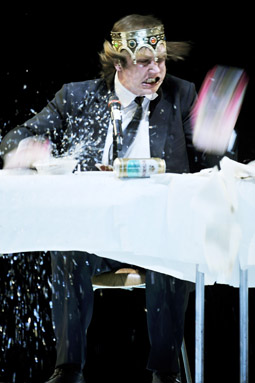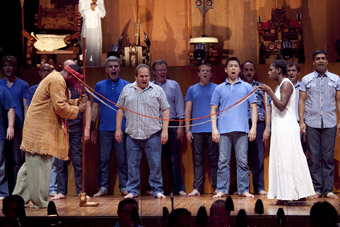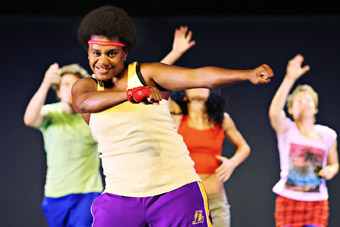in and out of the frame
keith gallasch: 2010 sydney festival

Lars Eidinger, Hamlet, Schaubuhne Berlin
photo Arno Declair
Lars Eidinger, Hamlet, Schaubuhne Berlin
LINDY HUME’S 2009 SYDNEY FESTIVAL WAS FRAMED AT EITHER END OF ITS PROGRAM BY SUPREMELY INVENTIVE AND INSIGHTFUL INTERPRETATIONS OF CLASSIC WORKS: SHAKESPEARE’S HAMLET AND STRAVINSKY’S OPERA OEDIPUS REX. EACH PRODUCTION DREW FROM THE ORIGINAL UNEXPECTED PASSION, HORROR AND PITY, AND, HAVING ESTABLISHED THE FRAME IT WAS TO WORK WITHIN (ITS MODES OF TELLING, PERFORMANCE STRATEGIES, VISUAL MOTIFS), SUSTAINED AND DEVELOPED IT WITH RIGOUR AND CONSISTENCY.
The Schaubühne from Berlin, directed by Thomas Ostermeier, delivered a Hamlet rich in excess and abjection yet able to switch from raucous comedy and spurious violence to moments of intense interiority and intimacy. This was not only because the actor Lars Eidinger is frighteningly adept at such shifts, but because his Hamlet is part of a world that is likewise angry, rattled, impatient and unpredictable and he more than most. Guns are fired at the dinner table, people yell (even Polonius at Ophelia while trashing his meal) and Hamlet intrudes everywhere with a video camera that casts images on a huge screen and reframes our understanding of what is happening to him.
Although other characters take turns at videoing for Hamlet, the tool is principally his but it does more than pry and document. Hamlet’s psyche sees what it wants to see—the huge screen recurrently turns a stale yellow with flying black flecks, like bats or ash. Within this enveloping nightmarish image Hamlet, ‘projecting’ furiously, can create a growling Gertrude out of The Exorcist (much later he spiels an exorcism over the Queen in evangelical American English) and then transform her into Ophelia (played by the same actress). When the camera is turned on Claudius we see him become Hamlet’s dead father (Claudius’ brother), the skull quivering beneath his flesh—another of Hamlet’s conflations and a chilling rendition of the ghost.
The set is a frame that is itself constantly being reframed. Filling almost the width and height of the stage and riding back and forth, downstage and up, it is pulled by the actors over a field of dark earth. The frame that houses the screen (long thin metal chains providing a dense curtain as well) can be separated from its base, so that the screen can stay upstage while the base with table and chairs rolls forward, or vice versa, creating sudden shifts in depth of field with a cinematic verve isolating, for example, a terrified Gertrude in a vast sweep of dirt while Hamlet maniacally romps about her.
A room in the court can open up into a muddy graveyard in which, in the play’s opening, a lone gravedigger struggles to lower a coffin, falling into the hole with it and bouncing up like Buster Keaton while a member of the court creates arcs of rain with a garden hose as if requested to add apt ambience to the funeral (recalling Claudius’ “mirth in funeral…dirge in marriage”). Later in the production there’s a wild hose fight reflecting the frustrations and anger felt in a rapidly collapsing court. It’s the ‘undue haste’ of the marriage of Claudius and Gertrude that seems to have provided the impulse for the production—things are spilt, get messy, people stagger (especially Claudius) and pratfall. Impatience and anger saturate the action. The swordfight between Laertes and Hamlet looks dangerously reckless. Hamlet goes at his “To be or not to be…” speech a number of times for different audiences, as if trying to get a handle on it, going further into it, swapping rational delivery for rant. The production is never short of restlessness and anxiety: Hamlet rattles everyone, and finally himself, uncertain where his actions have taken him.
This Hamlet is a clownish brat, spitting food, singing rock songs and giving way to physical abandon—falls, a flash of sexual intimacy with Ophelia, fights and punkish dancing. He chats with the audience, mocks someone for falling asleep, but enters his moments of interiority with remarkable conviction. His capacity for transformation—discarding his Hamlet ‘fat suit’ to play a sexy Gertrude in the play within the play—is astonishing. Other actors also excel: Urs Jucker’s Claudius sees himself in the master of ceremonies mould, constantly picking up a microphone, dropping chattily into the auditorium to deliver the first part of his confession before returning to the stage to sink deep into his fear and guilt. Again, the consistency of these sudden oscillations of states of being frames a dangerous world in which death threatens and beckons—marked by the constant presence of the downstage centre grave onto which characters fall or bury themselves or each other.
Shakespeare’s text has been cut and pasted and re-written a little into new shape by Marius von Mayenburg but with much fidelity to the original (the work is surtitled). With Ostermeier he has fasioned a Hamlet apt for our own angry, anxious times, drawing us into the consciousness of a man whose madness seems not to be in doubt but who is still complex and memorably affecting. The consistency in framing and motif makes for an engrossing production, not least in the attention to media: the camera, celebrity moments, microphones and songs, and Hamlet mocking Rosencrantz and Guidenstern by creating a mock turntable using a paper plate, fork and microphone, spraying out hip-hop and glitching while squirting juice over the pair from a cardboard container tucked between cheek and shoulder.

foreground Roderick Dixon, Elma Kris, Oedipus Rex & Symphony of Psalms
photo Jamie Williams
foreground Roderick Dixon, Elma Kris, Oedipus Rex & Symphony of Psalms
I’ve listened to Stravinsky’s Oedipus Rex often but found it somewhat austere. Peter Sellars’ staging and Joana Carneiro’s conducting yield surprising warmth and passion. Sellars has the large orchestra filling much of the lower auditorium floor space, making for a considerably improved aural experience in the Sydney Opera House Concert Hall. On a forestage just above the orchestra an all male choir, casually attired, assembles, and above them there is a narrow plain timber stage backed by a wall and housing four exotic thrones by Ethiopian artist, Elias Simé. Here the tale of Oedipus is enacted in simple costumes suggestive of ancient times. By placing the orchestra and the choir between us and the actors you’d think the effect would be distancing. But the framing provides a heightened sense of ritual and occasion (when Queen Jocasta enters to a trumpet blast, the house lights flood the auditorium. We almost stand to attention).
The choir play a key role in the layering of affect. They are a physical chorus as well as singers; schooled in a gestural language (presumably Auslan), they sign continuously, sink to their knees, fall and roll as one or in groups. The strength of their feelings is made visually as well as aurally palpable and the sense of an engaged citizenry is powerful.
The narration is delivered in English by Paula Arundell, with Sellars effectively casting the narrator as Oedipus’ daughter Antigone. The singing is in Latin, but with limited movement, emphasising courtliness and emphatic states of being, contrasting sharply with the vigour of the chorus.
Although they’re relatively far away from us, the spare staging and almost tableau setting allows for a clear focus on the performers. Movements are simple: Oedipus, his back to us, holds Jocasta affectionately as she sings, but as her resistance to the truth grows she moves to a throne and uses sign language rhetorically and evasively. Not unlike a Sellars staging of a Handel oratorio there’s a suggestion of psychological realism built from minimal means. The singing is superb, especially from Rodrick Dixon as Oedipus, a lightly toned tenor capable of great strength when required.
After interval Sellars changes the frame for Stravinsky’s more positive Symphony of Psalms, adding female singers, the chorus now surrounding the orchestra and lining upper aisles and again gesturing. On the forestage the blind Oedipus led by daughters Antigone and Ismene (Elma Kris) slowly traverses the stage before his disappearance into the underworld.
There were two striking if demanding dance works: Mau: Tempest without a body, from New Zealand’s Lemi Ponifasio, and Dark Matters by Crystal Pites’ Kid Pivott Frankfurt RM from Vancouver. Mau is rooted in Maori dance and culture but also contemporary performance and butoh. Walter Benjamin’s angel of history wanders the stage screaming; a group of monks glide about in fast, small steps and with beautifully complex gesturing; a man very convincingly becomes a dog; a Maori elder addresses us, first revealing his tattoos, later dressed in a suit; and a lone man appears to bend and collapse beneath the weight of the world until a moment of release late in the work. For all of its mysteries, Mau is an engrossing work suggestive of post-colonial tensions, environmental exploitation and a Pacific Rim cultural sharing. Recurrent movement patterns and haunting visual motifs (including a large hanging metal-like sheet that changes texture with light and projections) lend Mau a provisional coherence and implant a desire to know more.
Dark Matters has a more pronounced coherence but appeared to many to slip away in its dance focussed second half. In the first, a man makes a puppet (superbly manipulated by the dancers in black outfits). It turns murderously on him and triggers the destruction of his world—in this case a theatre set. In the second half the dancers alternate between group dancing (chains of elaborate cause and effect) and sublime off-centre duets (Pite has worked with William Forsythe). Among the dancers a puppeteer figure appears and in the final scene is released from her black outfit, taught to walk (by the young man from the first act) and move until she drains him of life. As he lies in her arms, she looks down at him, draws an imaginary thread from his heart and kisses him, bringing him back to life. In this reversal the dark matter of our desires that turn our passions and creations against us is revealed to be human, not abstract, no mere anonymous puppeteer. It’s a pity then that the protracted, fine dancing of the second half seemed to iterate and reiterate duets of interdependence, departing too far from the theatrical framing of the first half and the ending.

Ghenoa Gela, Happy as Larry, Shaun Parker & Company
photo Prudence Upton
Ghenoa Gela, Happy as Larry, Shaun Parker & Company
Shaun Parker’s Happy as Larry has a satisfying consistency built around a chalk board artist whose impressionistic documentation of his own state of mind and others’ movements begins to build into a major artistic creation. It’s made on a huge rotating black box out of which dancers and personalities of very different kinds manifest and then disappear, perhaps reflecting aspects of the artist’s psyche as he searches for a sense of self and achievement. Much of the work’s happiness theme seems provisional—a performer (Ghenoa Gela) impressively laughs without moving a facial muscle, dancers seem happiest when absorbed in their dancing, one performer’s risky virtuosity begins to worry the others—and the engagingly jaunty music has a melancholy string aspect that suggests a more complex mood. Warranting more review space than is available here, Parker’s subtly memorable work is full of invention, vivid detail, characterful solos and duets and, in the end a smiling ensemble, their happiness well earned.
Red Leap Theatre’s account of Shaun Tan’s The Arrival was done for the most part with great design fidelity to his drawings, although it had to reframe the story with a more obvious narrative and with an inclination to sentimentality (not a Tan vice) towards the end. The performers are solid actors, adroit puppeteers and fine movers. The Arrival should enjoy a long career on the festival circuit.
Festival disappointments included two Irish works. Oedipus Loves You is a punkish semi-musical account of the myth with limited thematic coherence and bad jokes. I’d have rather been at a Dylan Moran show. Giselle from Fabulous Beast began promisingly, a dance theatre work with spoken text and songs transposing the plot of the 19th century ballet to a deeply prejudiced rural village. The community takes to line dancing—innovatively choreographed—while the put upon Giselle’s life unravels. The final stages of the show lose impetus quickly with pretty standard wafty modern dance in the graveyard and a final fatuous image of Giselle trampolining from her grave. Why the line dancing motif wasn’t sustained is a mystery given its earlier integral role and the opportunity for it to be the trap offered by the ghosts of dead young women with which to snare young men. Save for Giselle (McCreedy) the other key female roles were played by men, often dextrously though without making a point as to why. Here was a production that slid out of frame.
Headlong’s Six Characters in Search of an Author was the greatest festival disappointment, not least because the praise lavished on it in London didn’t mesh with what we saw. The promise of a television industry framing of a classic work about identity and self image held much promise, especially after the experience of Hamlet. But the conceit was merely that and was never embodied, either technogically or performatively. Even odder was the presentation of Pirandello’s family, looking as if still living in the 20s, or somewhere thereabouts. Long sections of the original play had the contemporary characters propping up walls, while the decision to document the family drama was agonisingly negotiated. Amidst all the overacting, Ian McDiamard, as the father, made some cogent sense of the family’s plight. But the new, ironic post-theatre ending did nothing for the original conceit except to remind us that we were watching theatre about theatre, with nothing about the media, let alone the selves generated by it.
Muziktheater Transparent’s Ruhe [see David William’s review, p16] was an interesting case of limited framing. Sung beautifully by the members of Collegium Vocale Gent standing on chairs amidst us in Sydney University’s Great Hall, the promised interruptions to the singing were only two, and in the form of monologues delivered by actors moving among us. With numerous songs, this felt more like a concert than a music theatre work. Nonetheless it had a certain power in the juxtaposition of musical beauty, ugly prejudice and site, but after seeing Peter Sellars’ engagement with his choir, albeit in a substantially different kind of work and doubtless greater resources, I yearned for a little more adventuruous dramaturgy.
Hamlet and Oedipus Rex offered complete aesthetic and emotional experiences while Dark Matters and Mau: Tempest without a body suggested an integrity of vision if more challenging to interpret in what was an otherwise uneven and much debated 2009 Sydney Festival. Sometimes it only takes several successful works for a festival to leave its mark. Many people couldn’t get in to see Hamlet, but after all the word of mouth and media coverage felt like perhaps they had.
For more on the 2009 Sydney Festival, see David Williams on Ruhe; Caroline Wake on The Fence; and Ella Mudie on Olafur Eliasson and Lynette Wallworth.
–
2009 Sydney Festival: Schaubühne Berlin, Hamlet, William Shakespeare, translation Marius von Mayenburg, director Thomas Ostermeier, design Jan Pappelbaum, Sydney Theatre, Jan 8-16; Shaun Parker & Company, Happy as Larry, director-choreographer Shaun Parker, designer Adam Gardnir, composers Nick Wales, Bree Van Reyk, Riverside Theatre, Parramatta, Jan 22-24; MAU: Tempest without a body, concept, design, choreography, text Lemi Ponifasio; Seymour Centre, Jan 10; Fabulous Beast, Giselle, director Michael Keegan-Dolan; CarriageWorks, Jan 20-26; Headlong, Luigi Pirandello, Six Characters in Search of an Author, adaptors Rupert Goold, Ben Power, director Rupert Goold; Seymour Centre, Jan 19-31; Stravinsky, Oedipus Rex & Symphony of Psalms, director Peter Sellars, conductor Joana Carneiro, Concert Hall, Sydney Opera House, Jan 28-30; Pan Pan Theatre, Oedipus Loves You, director Gavin Quin, Seymour Centre, Jan 21-25; Musiktheater Transparant, Ruhe, Collegium Vocale Gent, Great Hall, Sydney University, Jan 25-29; Red Leap Theatre, The Arrival, creators Julie Nolan, Kate Parker; CarriageWorks, Jan 10-17
RealTime issue #95 Feb-March 2010 pg. 14-15






